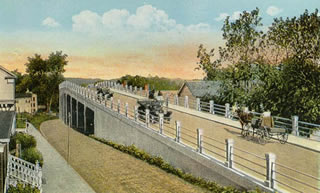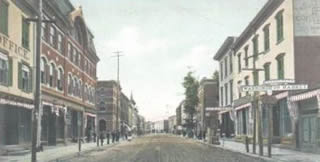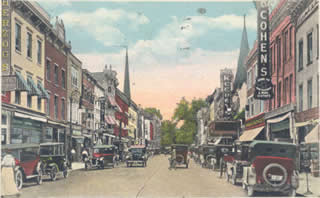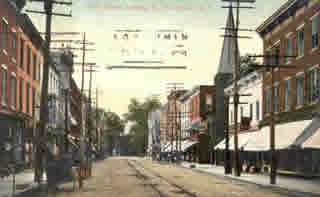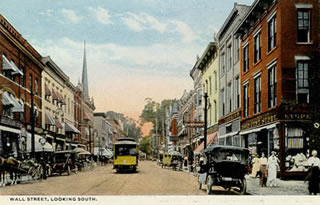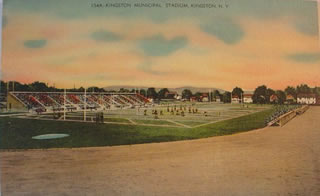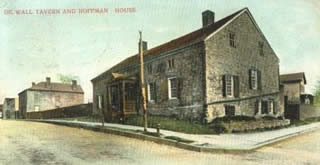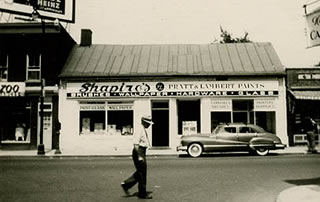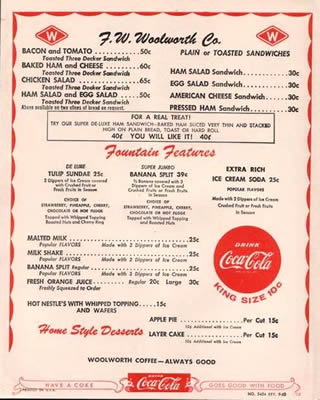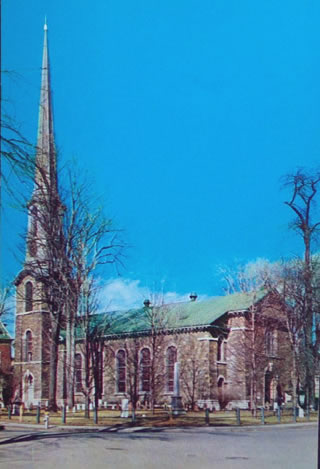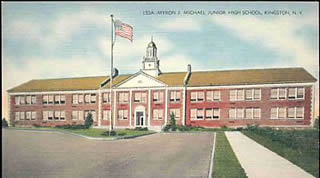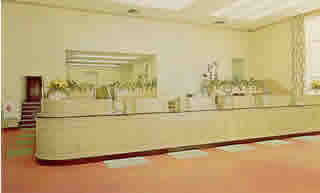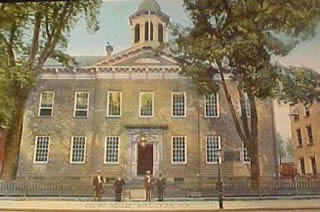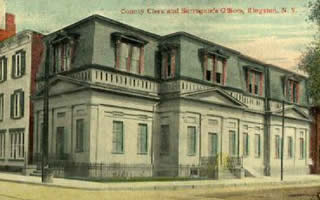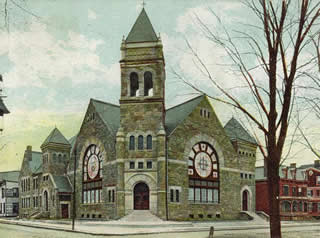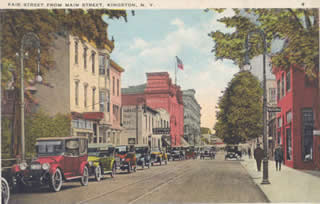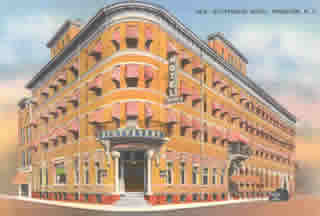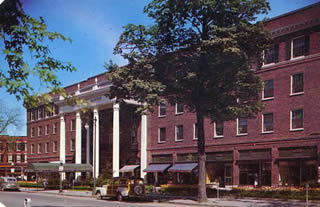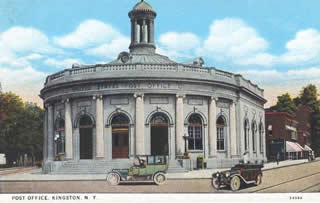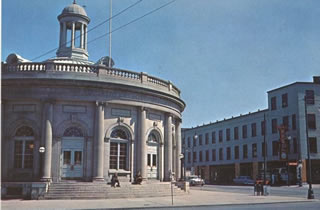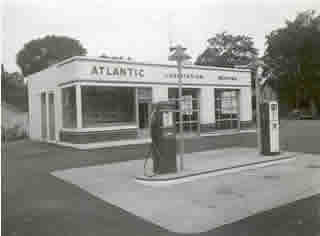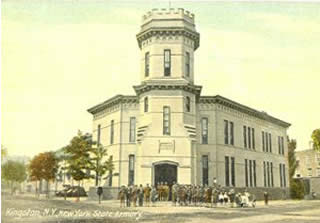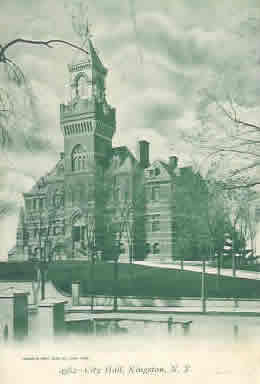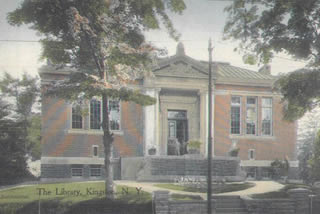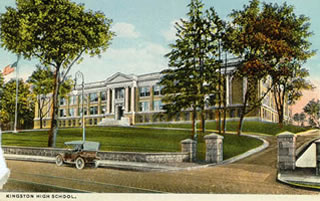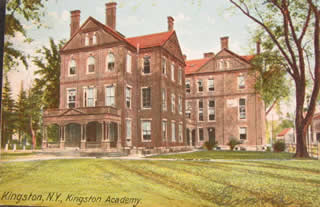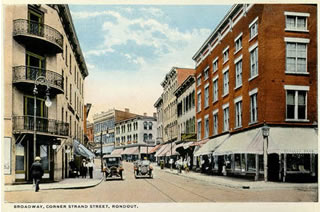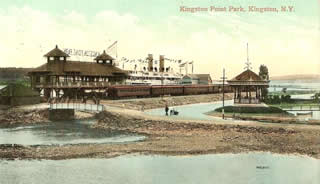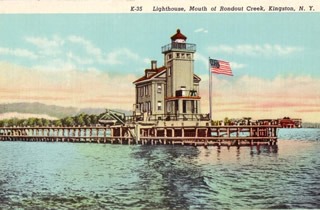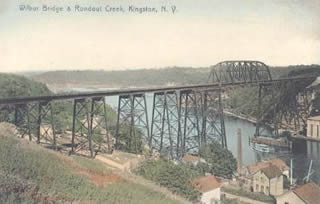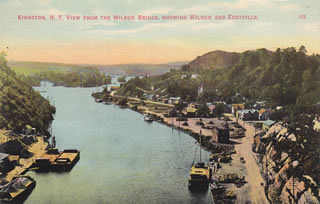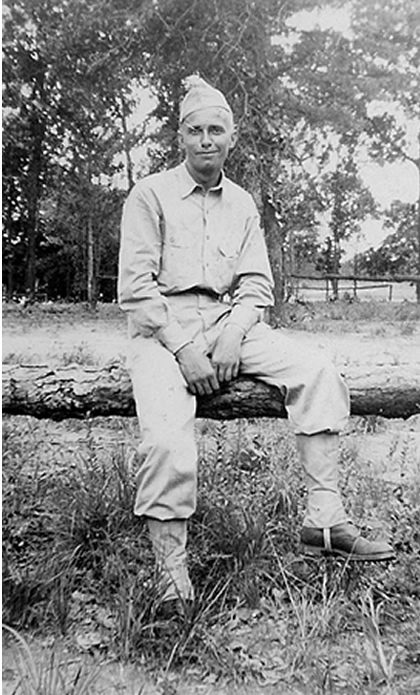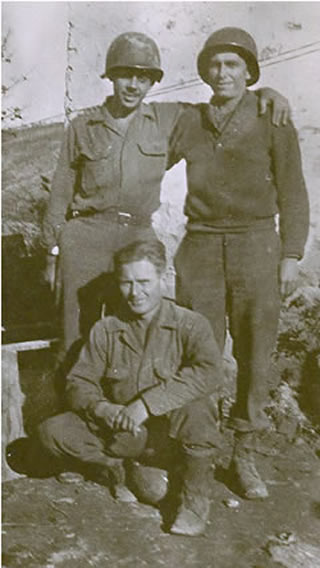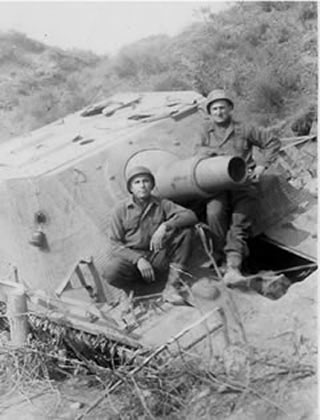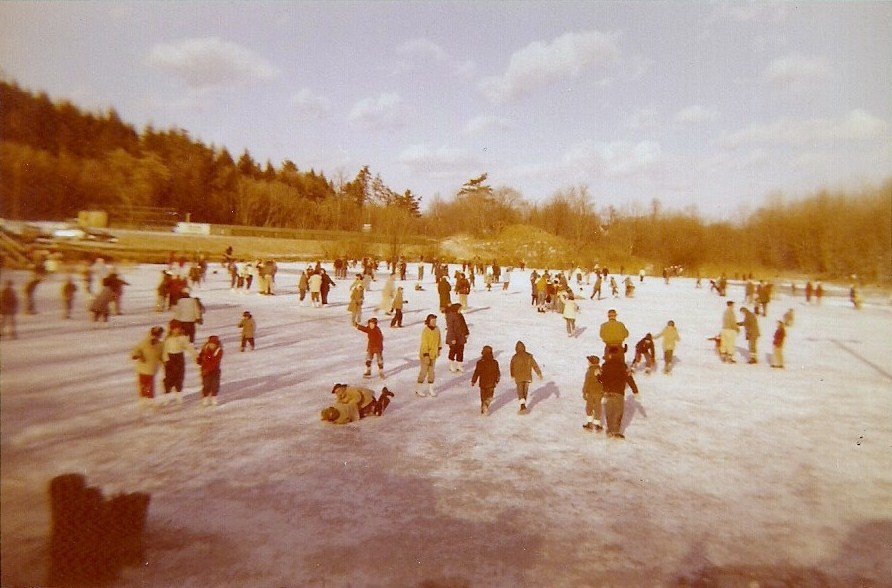|
|
Thank you Walter!
* Hold CTRL and tap + to make print larger *
|
Old Postcard Photos to jog your memory!
Remember the Washington Avenue Viaduct over the Esopus? I can remember visiting family friends on the dead end street that you could only access by driving under the Viaduct.
Wall Street in 1907
Wall Street in 1907
Wall Street in 1907
Wall Street looking South with the spire of the Old Dutch Church in the background.
Dietz Stadium
The Hoffman House - 1907, North Front Street at Green Street.
Who could forget Shapiro's Paint store on North Front Street (1946)
Parade up Wall Street in 1958.
Woolworth's Menu in 1960!
The Old Dutch Church, Wall Street.
Myron J. Michal Jr. High School
The Lobby of the Kingston Savings Bank on Wall Street as it looked in 1960.
County Court House on Wall Street.
The original Ulster County Clerk's Office replaced by the "Glass Menagerie" in the 1960's
St. James Methodist Church at Fair Street and Pearl Street.
Fair Street as it looked in 1925
The Stuyvesant Hotel on Fair Street in 1950.
The Governor Clinton Hotel at the head of Albany Avenue.
The YMCA on Broadway at Pine Grove Avenue in 1923
Memorial Day Parade in 1959.
The stately, original Post Office on Broadway before it was razed for a parking lot.
Post office and Trailways bus terminal.
Broadway Atlantic Station in 1954
Kingston Armory in 1910 - now the Mid-town Civic Center
Kingston City Hall
Kingston City Library - a Carnegie building.
Kingston High School - KHS - as it looked when new.
Kingston Academy
Broadway at the Strand in Rondout
Kingston Point Dayliner Park in 1909.
The Rondout Light House
The Wilbur Railroad bridge entering Kingston from Port Ewen.
View from the RR bridge of Wilber and Eddyville.
|
As published in The Lincoln Eagle Well, where does one start? For we Kingstonians who are in our mid-50's, there's been lots of change to the city, and much of it is not for the better. Some of the items may sound like cliches but they are no less true. There WAS more business in Uptown Kingston: I grew up in a family that never owned a car. (Wow! What a concept!) And you know what? We got around by walking, biking and taking the bus. Uptown Kingston had sufficient stores then so the walk to Uptown was well worthwhile. Woolworth's, Montgomery Ward, Newberry's, Yallums, Whelan's Drug Store, O'Reilly's, Elston's Sports, Schneller's, Saccoman's Jewelery, Mohican Market, Penney's, Yallum's, Rafalowsky's… There was the Bull Market and Shapiro's Paints, and Herzog's Hardware Store. Abram's Music, Standard Furniture, London's, to name a few. The various banks. The many churches, which are still there, thank the Lord. And to keep we young ones in fear of the law, the Ulster County Jail was behind the Court House. Yes, there were prisoners in it, looking out the barred windows, saying scary things as you went by. Then things started changing and the businesses moved farther out of town. The streets WERE safer to walk. Case in point, and my mother will probably shoot me for this one, BUT!.. Here we go. One of my earliest memories is going uptown with Mom, my brother Russ and my sister Nancy. Now, a carriage was being pushed so Nancy, the youngest, could not have been very old, which makes me about 4 years old and Russ about 6. So, up we went. It was a pleasant walk with fine weather. We walked up Wall Street to the corner of Wall and John. Mom had some business in the bank, the name of which I have forgotten. Well, the streets were bustling, as Uptown streets used to be. Mom decided to leave us three kids out in front of the bank so as not to have to maneuver the carriage through the lines. That may sound outrageous, but things were different then (talkin' 'bout 1955 now). I distinctly remember the people walking by us for what seemed just a few minutes to me. Well, Russ apparently decided we had waited long enough, turned the carriage towards St. Joseph's Church and started heading us home. I can still recall the wonderful trees we passed under on Fair Street. I recall sitting on our porch (We could not get into the house, of course, as the door was locked) when a police car pulled up in front. Hey, that was cool. It was a great surprise to me to see Mom get out of the vehicle, very upset, then very relieved, when she spotted us. I also recall Russ and the tall policeman talking together about somethin'. You can just imagine. So, here's the point. We made it home, kids about 6, 4 and 2 without any molestation. I just don't think it would happen that way now. I'm sure there was crime in Kingston then, but nothing like what we see today. Murders in Kingston! Rapes in Kingston! Gangs in Kingston! Drug peddlers from NYC in Kingston! I think of the poor Knox girl. Bodies found off Broadway and behind Kingston Hospital in the old railroad cut. Poor John Simmons' murder never solved. (Remember John? He worked as porter in Benedictine Hospital. A harmless soul.) Okay. Let's jump ahead a few years to about 1961. That's when I joined the Boy Scouts of America. We had a wonderful troop based out of the Old Dutch Church. That was Troop 12. That organization was blessed with a great cadre of adult leaders. I remember people like Gil Sampson, Al Stingel, Al Townsend, a Mr. McMahan, even Ed Ford, I think. The outstanding person, or course, was Ralph Shapiro. Looking back, it is very clear how fortunate we young fellows were to have caring, committed adults around who were willing to put in the time and energy required to provide an atmosphere which reflected the values of Family, Community, Nation and God. (By the way, there are still good folks involved in delivering the scouting experience to our young people. Check it out. Get involved. Ignore the ACLU.) And speaking of the Old Dutch Church, there used to be dances there every weekend. Battles of the Bands. Matt Marnell on drums. Steve Atwood on bass. Not necessarily in the same band, now mind you! I'm sure some of the church elders were beside themselves, but Bethany Hall was wall to wall kids every Friday. Here's the point. There was a safe, supervised place for young people to congregate. That was the mid-Sixties, as I recall. A year or two later, there was the Cellar Club at the YWCA. Again, a nice place for youth to get together and have some fun. Back to the scouts, here's an example or two of great learning experiences that surely have stuck with me. Al Stingel, one of the assistant scout masters, took a number of us to the lower spillway falls of the Ashokan Reservoir. This was when it was still okay to go below the bridge. We guys spent an hour or two cleaning trash from the area in the cold. taking several bags of garbage out with us. What did we learn? Always leave a place cleaner than when you arrived. Respect the beauty and purity of the outdoors. Today of course that area is off limits. Here in Kingston, there's more outright littering than ever, usually on OPP (other people's property), which seems to make it okay. Here's another. These days, there is the Scouting for Food event around Thanksgiving. This is a great project scouting sponsors. Bags are distributed to our neighbors one weekend. Their food donations are collected the next by the scouts. In the recent past, the food has been taken to the UPS facilities off East Chester Street Bypass for collection and distribution to various food banks. Back in the day, our collection efforts ended a bit differently than today. We actually delivered food baskets to those families that could use them. I'll never forget delivering several cartons of food to a needy family on Hasbrouck Avenue. The lady of the house greeted us when we knocked. She apparently had no idea the delivery was coming. As the food cartons were brought in, her surprise was quickly replaced by tears of gratitude and several God Bless You's. What did we learn? Though we were not part of the upper class, there were many who needed even the basics (Food!) much more than we did. And we learned that providing alms could make you feel good. Now, it's not safe enough for scouts to make the deliveries in person… or, if the deliveries were made, there would be the inevitable lawsuit, someone claiming the food was bad or poisoned, or "they got more than me", or the like. One last thing, though I could go on. Troop 12 had members from all the neighborhoods in Kingston. There was a great attraction - the Kingston Indians Drum Corps. Boy, was that ever a fun experience! We traveled to parades every weekend. (Not always on the best buses!) We competed in shows all over the Northeast. We got exercise, made music, learned unit discipline and teamwork. Got baloney and cheese sandwiches from the firemen's auxiliary after the parade. Hey, we sang doo-wop songs to attract the girls. Jimmy Brodhead, Danny Fiore, Barry Jackson, various others. Know what else? We learned to get along with and respect one another. There was no better place or way for us to learn that we was all Equal. Now? I hope there's still places/occasions beyond the sterile "diversity classes". I hope so. Well, this could go on and on. I'm stopping now though. I'm a bit sad thinking that one of the homes where we had scout patrol meetings every Saturday, Bobby Wells' house on Furnace Street, is scary even to drive passed, Heck, we used to walk there, and up Van Deusen Street, and down Clinton Avenue, with our instruments, day or night, without being scared. I'm thinking of Miss Anna Van Der Zee, Deaconess of the AME Zion Church, who was on my paper route. She lived in a small house on Pine Street which now borders the Pine Street Medical complex. Back in the day, that area was an old cemetery. Every Friday, when I collected the 40 cents per week the Freeman cost back then, Miss Anna would have me come inside. Usually, she would just count out the quarter, nickel and dime for the paper (along with 5 or 10 cents tip for me). Other times though, Miss Anna would sit me down and sing me hymns! Yes, she would. Ms. Anna was like that. She told me that once, when she was sick, the Lord Jesus appeared at the foot of her bed, and told her, "Don't worry, Anna. It'll be alright, Anna." I believed her then. I believe it now. She also told me how, when the power was off one night, and she had just heated she can of soup over one of the two burners of her natural gas stove, she prayed, "I thank you Lord, for this meal. But, Lord, it sure would be nice to have just a little light to eat my soup by." That's when the moon rose, and poured light through her kitchen window, right onto that soup and Miss Anna. Don't think prayer gets answered? Well, Miss Anna has gone on to her reward. I happened to be there when her nephew and the police found her, ill. I was walking up to Cellar Club and saw the cops there. I saw the poor dear finally answer her door just as it was going to be forced. I heard she went to a New York City hospital for treatment. Then I heard no more. That all makes me a bit sad too, but I'm glad I knew Miss Anna. Now she would be labeled a crank or worse for singing hymns to a paperboy. And saying she saw Jesus… I'm thinking of Mom giving lemonade or Kool Aid to the city guys who were paving the road on a roasting summer's day. You'll never see that again. I'm thinking of how we would shovel the snow from the fire hydrant and clear the storm drains, as an act of civic duty. Do you see that anymore? No, now we see sewer projects that go on and on, month after month, then break again within weeks of being complete. We see homes flooded with raw sewage, then see the city "powers that be" refuse to pay just compensation to the home owners. We see streets go unpaved throughout the winter because of poor planning. ("They are not making asphalt now, so we have to wait until spring.") Probably hear that about Wilbur Avenue this winter. That all makes me kinda sad too. And just a bit mad. As published in The Lincoln Eagle XIV October, 2008 Page 10 I guess Michael Marnell has plastered my high school picture in this article, but I'm not going to discuss Kingston High School in this piece. No, I'm going back further in my Back to School rant. All the way back to George Washington Elementary School on Wall Street. We walked there. Truly a neighborhood school. No busing at that time. If it snowed, you went to school anyway. And knew all the kids because they were from the neighborhood. Kindergarten: Mrs. Maclean. I visited this classroom with Mom a few days before the school year actually started and was introduced to Mrs. MacLean. She was a wonderful, kind woman whose class contained... Monkey bars!! Well, I was up in those so fast you wouldn't believe it. Mom and Mrs. M. laughed and talked and agreed I'd be fine. Hey, I thought so too what with monkey bars in the room and al1. So, the big day came. On I went for a school year's worth of those half-day sessions. Ready and willing and able. Imagine my chagrin, then, to find...No Monkey Bars!! Someone had fallen from them on his/her introductory visit. The bars were pulled. We never again saw them in the classroom. It was my first exposure, though I did not recognize it at the time for what it was, to PC… Political Correctness. Oh well. So what? We still finger painted, played with those big wooden trucks, ate the white paste glue, got naps and a carton of milk, played store, listened to Mrs. MacLean read to us. Struggled with the basics of the Alphabet, learned to read, etc. And learned all we needed to know to make it in life, as somebody said in a book. I loved Mrs. MacLean. And still do. 1st and 2nd grade: Miss Elmendorf. Both years!! What a change from Kindergarten. In school all day! And hard! And sometimes not fair! The Mary Stephanie Corsones and the soap eraser dust that I got cracked across the knuckles for comes to mind. Yeah and there was no one to complain to or sue over for the application of corporal punishment that unfairly came my way. After all, Mr. Boyd, the principal of George Washington Elementary had a paddle displayed on the wall of his office labeled, "Board of Education". The display of that piece of lumber was enough to keep us all in line pretty well. I remember only 2-3 paddlings being talked about in the 6 1/2 years I spent with those brick walls. And that's out of how many hundreds of Baby Boomer kids being educated?? Anyway, Miss Elmendorf, was always in a long black dress, was tall and thin, frankly reminded me of Miss Gulch from that famous old movie (Look it up! I'm melting...) and had even lost the tip of a finger when a wooden screen door on her family's Midwestern farm house slammed shut on her hand. Actually, I received a fine education in her class. And she wrote great comments on the report card. I learned several years ago that Miss Elmendorf was in her last days, living in the nursing home that used to be on Albany Ave just past the Sharpe Burial Ground. I went to visit her. She was well in her 90's. Miss E. did not really remember me well. After all, there had been so many children and I was no one special really. But I still had my report card and showed it to her. She read the comments. And said, "These would be good on a resume." Here they are. "Walter is a darling little boy. He has a keen sense of right and wrong. He is alert, capable, dependable and an excellent worker. He is a good listener and follows directions. He enjoys school and is a friend to all." Bless you Miss E. 3rd Grade: Mrs. Dunn: A really nice lady. I don't remember us giving her much trouble. The main thing was that I was one of the first kids that caught the German measles that December. Seems to me I was out of school quite a few days. But, when I returned, it was close to the class Christmas party. (Yes, there was a Christmas party, diversity be durned!) So, I returned to a class with many, MANY empty desks. The German measles had just rampaged through the whole school apparently. Anyway, I was treated as something of a returning hero. Why? Because Mrs. Dunn had bought every student a small Christmas present. Since the class had been temporarily decimated, all we returnees or immunees got EXTRA PRESENTS'! So there's that Silver Lining you hear people talk about. 4th Grade: Mrs. Roosa's class. We were exposed to French lessons piped in over the PA system. Dinosaurs and rocks. How could one not like this grade? Well, we did do the brain transplant thingie behind the old backboard on the playground. Transplanted a "smart" kid's brain into a "dumb" kid's brain. No names here. So, somehow the word got back to Mrs. Roosa and we had to apologize to the ''dumb" kid, who wasn't. It was all in what we thought was fun. I think the receiver of the apologies was as mortified as we apologizers were. And I was, and stayed, friends with both of these guys. Mrs. R. gave me, at the end of the school year, a huge chunk of sandstone loaded with shell fossils. It was several weeks into the summer before that rock was completely split up and the shells extracted. 5th: Grade: Mrs. Norman's class. A tough lady. Mike Hawkins once was seriously berated for supposedly making a face at Mrs. N. when in fact he had simply been wrinkling his nose to push his glasses hack in place. We all knew the truth of the matter, but there was nothing to be done. Mrs. N. kept us in line. Roger Thiel and I both had broken a foot in the Fall, so for a while we got to eat lunch in the classroom while everyone else was in the cafeteria. Us hobbling along on our crutches was considered too dangerous. A very wise call, if you remember the GW halls filled with kids, and hungry ones at that! In the 5th grade we all were required to give a little presentation in front of the class (Hated that!!). The presentation was to be about a bird of the North East. The bird one was to speak about was assigned to us by Mrs. N. You see Mrs. N. had a set of bird cards with a great picture of the bird on the front and some starter info on the back. These cards were the personal property of Mrs. Norman. We were all given a card to take home and study. And Mrs. N. wrote our name on a list so she knew which card she had assigned to you. She wove quite a tight web. Well, guess what? Mine got thrown in the garbage somehow. After digging through a can or two of trash, there it was. I can still see the dried eggshells and coffee grounds on the picture of the bird, though I cannot remember which bird I had been assigned.. This turn of events was devastating. How am I to explain to Mrs. N. that this was all an accident? The card was from her personal collection. Remember how Mike H. had been treated for just wrinkling his nose at the wrong time? So, my parents looked at the card, found the address of the card company and wrote away for a complete boxed set of these cards. Now the suspense built. Day after day. Would the set of cards arrive before it was my turn to speak on the bird? Mrs. N. was proceeding alphabetically so here was a time where being a "W" kid worked to my advantage! She was calling a kid a day, or more it seemed. Rob Astelos, Susan Blakely, Linda Fischang, Mike Hawkins, Dorothy Metcalf, Danny Moore... Boy, the tension was really thick, and my doom was fast approaching, when, at last! At the beginning of June! A box arrived! It was from the card company! Saved! Saved! Mom and I opened that wrapping, my heart was beating so! Life would continue past 5th grade and into the summer! But... Wait... The set of cards was for Birds of the SOUTH East United States. And, and my card was from Birds of the NORTH East United States! What kind of cruel joke was this? I riffed through the whole set of cards looking for mine. No luck. It was not there..... My parents let me know there was no way the correct set of cards would reach us by school year's end even if they returned the set. Doomed. Doomed. So, I did my best to clean up the card. Memorized it as well as I could. Added more facts from other sources. Could not see past the coffee ground stains though. Couldn't see how Mrs. N. would not notice. And the days of 5th grade trickled down to a precious few. My doom was nearing... When, a miracle happened. Yes, miracles do happen. Mrs. N. had apparently been told to prepare us for some special exam or another. There would be no more bird card presentations. "Those of you who had not yet given your talk, count yourselves lucky and bring your card up here to the desk and return it to the stack of other bird cards." We blessed few brought those cards up to Mrs. N's desk. I buried mine deep. Deep into that pile of cards. And got out alive. I think it was during an assembly in 1961, that we watched Alan Shepard become the first American in space. You have to remember that we had all seen rockets aplenty blow up on the launch pad. Unmanned ones of course, with only satellites or the occasional monkey. But this was a manned flight. I remember the tension and silence as we all watched the countdown on a TV set up on the auditorium stage. When the engine roared into life, and the rocket ascended, I remember Mr. Boyd hurriedly whispering something to Mrs. Plank, our Music teacher, while giving her the keys to the organ down by the stage. Mrs. Plank rushed to the organ, opened it and led us in a rousing chorus of, well, either "The Star Spangled Banner" or "God Bless America". Either way it was great. 6th Grade: Mr. Ascarino's class. Not a bad start back. New kids from the Hurley school so that's neat. On the second or third day of class a new girl arrives. Jean Lown. Quite a pretty young lady but she is obviously so nervous! I have never seen such a pale face. Alabaster. But we make her welcome and she fits in. One of Mr. Ascarino's activities is a demonstration. We all have to get in front of the class (Hated that!!!) and do our demo. Mine was how to load a (toy) muzzle-loading rifle. Into Civil War even then. Obviously not something everyone paid attention to. And I zoned out on some demos myself. It was Bette Jean Weisman, I think, who did her demo on how to properly set a table with the plate, glass, silverware, etc. Well, my lack of attention must have been palpable because Mr. A. directed me to come up to the front of the class (Hated that!!!) and show what I had learned from Bette Jean's demo. Obviously it was .... not much. I tried to put the silverware into the right places. Mr. A. asked Bette Jean if the placement was correct. She said, "No." and I slunk back to my seat. To this day, I cannot set a table. Gotta be PTSS. And although I did pretty well in class work, I did receive a "D" in some subject or another. Mr. A's comments included him saying that it really should have been an "F"!! Boy, don't you know I hated to bring that report card home and show Mom and Dad. Mr. Ascarino went on to be principal of GW School for a short time. He had a fatal stroke or heart attack only a few years into that job. I remember how the yellow chalk dust looked on his fingertips. Funny, huh? 7th Grade: Myron J. Michael. Split sessions. My brother Russ and I went in the afternoon. Around Noon to 5:3Opm or something like that. Why? The Kingston School Board had put up a proposition to fund building a new junior high school. The voters rejected it. The board got even by coming up with this split sessions idea. The proposition passed the next time it was put to the voters. Mr. Glennon was our Art teacher. An ex- corrections officer - and big. I once walked up behind him and clapped him on the back, saying, "Hi Mr. Glennon, old buddy, old pal." He spun around and hefted me into the lockers like a bagful of leathers and told me to never, ever do that again. I did not. Mrs. Kemble was our Science teacher. Her greatest story was about drinking out of a stream in the woods. The water looks clean, but how do you know that old Mama Moose hasn't just dropped dead a little upstream? That got us thinking. So did this. We were in the 7th grade during the Cuban missile crisis. Again, in split sessions, we were in school as sunset approached. I remember looking out her classroom window at the sunset colors thinking, "This is what it would look like if an A-bomb went off." Ah, those Golden childhood memories! At the end of the school year, I got my traditional baldy hair cut. Little did I realize that I'd have to go back to school for finals or something. Kids being what they are, guess who was the target of much humor, jest and ribbing? It was the last baldy haircut I ever got. 8th and 9th Grade: In the brandy new J. Watson Bailey Jr. High School. Things were so new that, for a while, I rode on a bus to school! Man, that was something different. Naturally, it did not last. Apparently, my house was about 100 yards short of the line to legitimately be a bus student. The district had made an error in telling us we could ride to JWB. I was not the only one called into the cafeteria and told our "free ride" was over. Since I had been raised to not accept such things as free rides, this comment rankled. I said something to the school suit, like, "What? You told us to get on the bus! We did not just sneak on!" Well, he apologized and slunk back to wherever he had come from. That momentary triumph did do something to expiate the long walk. But not much. Mr. Deschenes was one of our science teachers. He was from Massachusetts, and we were in his class when it was announced over the PA system that President Kennedy had been shot in Dallas. Mr. D. came close to tears. We were all sent home. Then there was the lab work I did for Mr. Mercier. We all had to assist Mr. M. at least once to prepare for an upcoming lab. For my stint, we had to prepare for dissection - of mice. So, we had to load I don't know how many mice into one of those big white paste glue jars which was empty, screw on the lid, punch a hole in the tin lid, feed in a gas line tube used for the Bunson burner, cover the jar with a cloth, and turn on the gas. Lovely. I may have been assigned that special duty because I once wore a WW I gas mask into class. The formaldehyde smell you see. Mr. M. just walked over and stood next to me, as the class chortled, and the mask was removed. I believe a chuckle actually escaped Mr. M's lips too. And I failed geometry in my time at JWB. Mrs. Hannigan was simply too attractive, and my concentration waned. Then there was Mr. Bernard, the Hispanic French teacher from South America. Those of you who were in that class know what transpired there. I will not go into it. Suffice it to say, Mr. B. was not with JWB the following year. Somewhere in the two years, Stan Albright gave Mrs. Thiel, a French teacher and mother of my good buddy Roger, a scare by hanging out of the second story classroom window just to get a rise out of her. We were pretty rotten and got yelled at more than once. And there was only one person who could take that type of punishment and not be punished by it, no matter what. That was Mike Lipp. Mike could hang his head in contrition at durn near a 90 degree angle with his shoulders!! Think about that. It was incredible to see. Couple that with the way he pouted out his lower lip and you had a work of art going on right there in front of you. Many tried mightily to match or better Mike in this, and Bill Brinnier came real close, but none could surpass the Master, Mike Lipp. Well, that's it. All that schooling did indeed provide an education - in scholarship, citizenship, camaraderie, respect and sheer fun. Wouldn't have missed it for the world. Would I do it again? Thankfully, that question need not be answered! Ring, ring goes the bell!!
Well. The Fourth of July in Kingston, back in the day. Hmmm. You know, it must have been the hazy, crazy days of summer, because basically what I remember is the heat and fireworks. People talk about heat now but I swear it was hotter in the summers of my youth. Just like there was more snow. So go figure. Yeah, heat. And I recall going to Berlin's store on Pine Street, pushing through a curtain of shimmering sun, scared to death, because the radio (must have been WKNY because there was no FM then) had been advising us all to beware of packs of dogs that were roaming the town, gobbling up young people. Well, so it seemed to me anyway. That was probably one of my quickest trips ever to the store! The fireworks were fired off at Dietz Stadium then. There must have been "doings" before the show, as we arrived in the daylight, but, whether it was those hard wooden benches, or the anticipation, I'll be darned, I just can't recall. The stadium had been named after Robert H. Dietz, Kingston's only Medal of Honor winner. On March 19, 1945, according to the Medal of Honor citation, Staff Sergeant Dietz moved "… forward with his men to protect engineers while they removed the minefield and the demolition charges attached to the bridges, S/Sgt. Dietz came under intense fire. On his own initiative he advanced alone, scorning the bullets which struck all around him, until he was able to kill the bazooka team defending the first bridge. He continued ahead and had killed another bazooka team, bayoneted an enemy soldier armed with a panzerfaust and shot 2 Germans when he was knocked to the ground by another blast of another panzerfaust. He quickly recovered, killed the man who had fired at him and then jumped into waist-deep water under the second bridge to disconnect the demolition charges. His work was completed; but as he stood up to signal that the route was clear, he was killed by another enemy volley from the left flank. S/Sgt. Dietz by his intrepidity and valiant effort on his self-imposed mission, single-handedly opened the road for the capture of Kirchain and left with his comrades an inspiring example of gallantry in the face of formidable odds." S/Sgt. Dietz saw no more 4th of July celebrations in Kingston. Now when the show started, it was always great. Being that close, and that young, each shell produced a show all by itself. For several years, it seemed like that light show would never end. And then came the grand finale. There would be some type of firework fountain, then a stream of contrails and colors that built and built in intensity, ending with concussive shots that were nothing more than giant flashbulbs that had the added benefit of slamming a wave of that hot air into your chest. Color and light made palpable. What a concept! Then it was over till next year. The last show I saw in uptown Kingston was the bicentennial display on 1976. Bob Stingel and I were out in the field, facing the stands. After one resounding shot, a paper base of the firework shell rolled up to my feet. Bob wrote a little note on it, something like "Happy 4th! Boom!". I still have that somewhere. Over those years, the length and quality of the fireworks show seemed to lessen. As we got older, and friends started driving, the trip was made to Saugerties for a better show. It was a great show, better than Kingston's but a real pain to get out of town. These days, Kingston's show is very good again. My getting older may have helped weaken the intensity of the Fourth. But then, other factors helped bring that intensity back. Like a love of U.S. History. So, besides the date of the Declaration of Independence, the 4th, in 1826, is the date that Founding Fathers Thomas Jefferson (He wrote the Declaration, remember) and John Adams both died, within hours of each other. It's the date that Confederate Vicksburg, the key to controlling the Mississippi River, surrendered to U.S. Grant in 1863. And it's the date, four score and seven years after 1776 that two armies rested after three terrible days of battle at Gettysburg, PA. A good number of men from Ulster County took part in the battle. Here's a few stories. Theodore Gates found himself in command of his own 20th New York State Militia, made up of men from Ulster and Greene Counties, as well as the 151st PA on July 1, 1863, the first day of the battle. After holding the extreme left flank of the Union Army of the Potomac's line, the Confederate pressure became too much and retreat was ordered. Gates had been one of only two officers on horseback at this part of the line, making him a very conspicuous target. To steady the men and maintain an orderly withdrawal, Colonel Gates grabbed the 20th's regimental flag, hoisted it aloft and called on the men to stand by the colors. This the men did, retiring slowly from the field, firing continuously at the pursuing enemy. Gates was miraculously unscathed. Colonel Gates and the 20th NYSM were not done with battle. By July 3rd, the regiment had been shifted towards the center of the Union line. At approximately 1PM on that sultry afternoon, a great Confederate cannonade announced the start of Pickett's Charge. Gates and the 20th took part in repelling the attackers, moving from the Union line to counterattack the right flank of the attacking Rebel column and aid in repelling it. Thus did our local men play their part in this great drama. Gates lived through the action and saw the 4th of July on the battlefield. He survived the war and is buried in Wiltwyck Cemetery. A friend recently reminded me of Gates' heroism. It is now impossible to pass that citizen-soldier's final resting place without seeing him with the colors, riding, exhorting, encouraging by example. A brave, brave man. Another locally-recruited regiment was on the Gettysburg field. The 120th New York State Infantry was involved in the July 2nd fighting as part of General Dan Sickles 3rd Corps salient. The men were ordered to lie down behind a slight rise to await the enemy's approaching attack. Lt. Edward Ketcham, Co. A, a Quaker from Gardiner, had been observing the enemy drawing nearer. This was his duty to do and he was not lying down. His captain, Abram Lockwood, had just advised Ketcham to exercise care. The lieutenant replied, "A dead man is better than a living coward.," and was then hit and instantly killed, probably by a sharpshooter's bullet to the head. It is said that when hit, Edward put up his hand and said, "Oh!", then fell. Ketcham is buried in the Friends' Burial Ground in Milton. He had seen his last 4th. Edward's brother, John, was a 2nd Lieutenant with Co. M, 4th New York Cavalry. He was on the field as well. He tried several times to retrieve his fallen brother's body, but the fire was too hot. Some 36 hours after Edward fell, John finally succeeded, and interred his brother's body under an oak tree using shovels provided by a nearby artillery battery. What a bleak 4th for John, who then wrote home to tell his mother the heartbreaking news. John himself did not see another July 4th . He was captured shortly afterwards and died in Libby Prison, October 8, 1863. Another officer of the 120th NY followed Edward Ketcham, though he survived several days after the fighting had ended, dying of his wounds on July 22, 1863. This was Lieutenant William Cockburn, considered by a comrade to be "a young man of noble qualities and excellent promise". Worthy of note is Willie's mother, Anne, who undertook the trip to return her son's remains to Kingston. Just a few moments' consideration given to the difficulties involved in traveling 1863-style, and navigating the ravaged post-battle environs and burial grounds of Gettysburg should give anyone a new appreciation to the depth of a mother's love for her children. I have seen a photograph of this woman. The strength, and the grief, and the anguish is there to plainly see. Mother and son are buried in Wiltwyck Cemetery. It goes without saying that the non-coms and privates were the backbone of the fighting prowess of these two fine regiments from New York. Here's one common 120th NY soldier's comments from a letter home: "...there I saw [Pvt.] Henry Skutt [Schutt, Co. K, 20th New York State Militia WIA Gettysburg July 3, 1863]. The 20th Regt was there that day. We marched 29 miles and I saw some of the best land in Maryland...we marched on till we came into Pennsylvania and there we found the rebs and we march into camp the 1st of July...the next day we went into the battle and we had a hard time of it. Our Captain A. G. Barker...was shot dead and William Holenbeck...was shot dead...Alexander Layman...was shot through the side and in the left leg bad...I was shot in the right leg. I am getting along first rate. They are a moving them off as fast as they [can] to Baltimore and Philadelphia and New York. As soon as I get there I think that I can get a furlough and get home...we lost in our regiment 200 and 5 killed and wounded, 100 killed, 105 wounded, 8 officers killed and 6 wounded. The 20 regt was all cut up too but we whipped them and took 15 thousand prisoners killed and wounded 17 thousand...". Well, maybe, but you get the point. Lastly, an unknown soldier buried in the Gettysburg National Cemetery was recently almost certainly identified, with the help of Seward Osborne of Olivebridge, NY. 1st Sgt. John S, Snyder, Co. A, 120th NY Infantry lost his life on the field. He was one of two sergeants from his brigade who perished, but whose body was unaccounted for. That situation is all but settled now. Sgt Snyder is buried in plot #83 in the New York area of the national cemetery. John was 38 years old and from Kingston. A memorial stone to him is in Wiltwyck Cemetery. So, I'm back to really enjoying the 4th of July. Mainly for the fireworks. The light, the noise and the smell of the gunpowder rivet my attention to the sky. But I see a lot of our history in and amongst each airburst. May it always be so. God Bless America!! And Happy Birthday to Us All!!!!
The Troop 12 Kingston Indians Drum Corps was around for a long time. I'm not sure when it started or when it ended. My time was from 1961 to 1966 and it was a great experience. There was a great bunch of guys to pal around with and a great cadre of adults donating time and riding herd. Some of the guys were, in no particular order, Dennis Robinson, Wayne Grey, Pete Wells, Russ Witkowski, Ernie Townsend, Bob Stingel, Matt Marnell, Doug Ellsworth, Bobby DuBois, Barry Jackson, Pete and Eddie Nekos, Danny Fiore, Jimmy Brodhead, Tom Kelly, Al Stingel, Bill Reynolds, Mike LeFevre, Jerry Yaple, many, many more. Some of the adult leaders were Al Townsend, Mr. Spencer, John Amorello, Mr. Marnell, Mr. Stingel, Mr. McMahon, Steve Nekos, Mr. Wells, Mr. Sampson, many, many more. Oh, and let's not forget the backbone, motivator, energizer, organizer, Boy-am-I -glad-he-was-there Guy - Ralph Shapiro. And let's not forget the Moms that did a lot for us. Mrs. Marnell, Mrs. Grey, Mrs. Kelly, my Mom, Mrs. Sampson, Sis Nekos, many, many more. My mother just reminded me that it was Mrs. Sampson and a dedicated group of ladies that sewed together and kept in good repair, our woodland Indian uniforms. Hats off to the ladies!! The drum corps traveled to parades every weekend during the summer months. Most parades were fairly short and very pleasant. We exercised, saw a new town, showed off for the local girls, and got fed baloney and cheese sandwiches. Maybe even snuck a little beer from the kegs at the Fireman's Day parades! Many times we paraded locally. One local parade stands out. It was an evening parade in Kingston for the city-sponsored Halloween party. We were all a bit skittish about that one, but Ralph told us we could wear Halloween costumes, not our woodland Indian uniform. So that felt better. We marched down Broadway. Before going too far, the shower of shaving cream and eggs and other things started to descend on us. I myself got a rotten tomato on the back of the neck. Did Ralph have a premonition designed to protect those uniforms. Maybe… Practice. Boy, did we have to practice a lot! Monday nights would be in the Old Dutch Church, unless the weather was good enough to get us outside. I started as a second bugle. If one got good enough, one moved up to first bugle. Since some of the songs in the early days were not all that challenging, we second bugles might play just 2-3 different notes through the whole song. Inevitably, since the note "G" was in there, we soon picked up the nickname of "The 'G' Boys". The older guys would remind us of our status with such lines as, "Gee boys, I thought you could do better than that!". Ah memories! Anyway, we would arrive clear of ear, and supple of wrist and lip early in the evening and would leave 2-3 hours later tripping over our lip, constantly repeating the question,"What did you just say?" due to the stupefying effects of power-playing in those small rooms in Bethany Hall. Hey, that could be why the east wall of the Old Dutch Church now needs support. We also had marching and maneuvering practice at various locations in the area. Some Sundays, when the weather was less than ideal, we would meet at the Kingston Armory on the corner of Hoffman Street and Broadway. We would also practice in the Kingston Plaza, which was known as Britts Plaza back then. The marching and maneuvering, affectionately known as "M & M", would occur in the summer and fall on various weekday evenings and on Sunday afternoons. It's many a mile we trudged in the Britts Plaza. Britts was in the Hannaford building. It was a great department store. Santa appeared there every Christmas, there was a cafeteria at the far end, and there was a big record department! Anyway, we practiced in the parking lot to the right of the building which was unencumbered with the covered walkways that are there now. So, there was lots of room for marching by the right flank, by the left flank, by the right oblique, by the left oblique, etc., etc. Do any of my ole corps buddies remember this command? "Double to the rear with a slight hesitation, change step, change step, harch!" Yeah, I tried it in the backyard today. Needless to say, that ship has sailed! One practice session stands out. There we were, tired and in a company front facing Britts, to our left was Clinton Avenue, to our right was Col. Chandler Drive. Ralph was in front of us with his back to Britts, delivering one of his world-famous pep talks, extolling us, in his way, to do better, try harder, be the best we could be. Suddenly, from out of the corner of our left eye, in the sky, appeared this huge fireball! No kidding! A fireball that moved from our left to our right, crossing our front and disappearing from view behind those trees across Chandler Drive. I've often wondered what Ralph must have thought, because every head traversed in unison, to the left, to the front, and to the right as we watched that fireball pass and, seemingly, fall to earth out in Ruby, or Saugerties or someplace over that way. And I for one will swear to you I heard a hissing sound as it passed. An awed silence followed for a few seconds, except for Ralph still going on. Then, 50-odd voices clamored, "Did you see that? What was it? Did it land close by?" "Whoa!" "Cool!". I learned years later that a large meteor was reported as entering the Earth's atmosphere above Canada traveling to the southeast and landing in the ocean. I guess that's what we saw. Maybe…. There was another place where the corps watched something come to earth. We were practicing out by IBM in Lake Katrine on the grassy lawn at the end of the science building across from the main plant, facing Rt. 209. Again, all eyes went to the skies as a small single engine plane appeared, experienced some sort of trouble, banked to its left and landed at the far end of the same grassy lawn we were on! One of the adults saw it and stopped us, avoiding anything like a near miss. Pretty cool watching that landing. And we competed in many places. These competitions got more serious as we, frankly, got better. Thanks to our adult leaders, and all that practice, we became better musicians and marchers and more adept at learning and executing a 15 minute M&M drill. This performance was delivered around the Northeast. We competed against drum corps from all over, and we were pumped enough to want to do our best, and win those darn shows. I guess Ralph's pep talks sunk in, eh? Psyched to win? One example. Chicky Buboltz (Hi Cuz!) moved from the color guard to the drum line, playing the bass drum. Chicky worked hard, put his heart and soul into every beat. Now, these competitions took place through the summer, for the most part. So, almost every July and August weekend we were someplace competing. After practicing, after parading, in that summer heat and humidity…...well, for awhile there, Chicky was known to make it over the finish line, pound that bass as we finished with a flourish… and then unceremoniously pass out, with the bass drum still attached. He was always okay and usually got a nice hand from the crowd, because he would march off with us, even if someone else carried drum. You sure worked hard, Cuz. Another competition locale was Agawam, Massachusetts. This place stands out because of the great amusement park there. It had a really BIG roller coaster. We stayed in a hotel, with a number of the guys in each room. We were hanging out when some of the older fellas, my dear brother Russ included, arrived with a pizza, explaining they had bought one pie too many. Would we like to buy it? We jumped at the chance, pooled our coinage, and paid out for the pie. The older guys smiled and left, we congratulated ourselves on our good fortune, opened the box… and found a pizza with absolutely no toppings!! I mean even the cheese was gone! Yup, just sauce, crust and denuded dough. Sigh! Another memory. We were in New York City for a competition or parade. Our lodging consisted of us in sleeping bags, spread out on the dance floor in some hotel's basement. Well, just hanging out there got boring real quick, so the plan was hatched to sneak out and stroll down the streets of New York. Somehow several of us got out and started strolling the City That Never Sleeps. And boy was it lively for this Upstate kid. So, things were okay until this rummy approached and tried to bum some money from us. He was persistent. We couldn't shake him. But then two NYC cops walked up and told the guy to move on. When he didn't, and gave them some lip, a nightstick got jabbed in his solar plexus. That settled his hash. The cops then turned to us, asked a few pertinent questions, then strongly advised us to returned to the hotel ASAP. We might have hesitated a minute or two before turning around. Maybe… One last performance to mention. The corps had been improving in ability. We moved up from a Class C corps towards the really good guys like the Garfield Cadets. Well, we actually received an invitation to play ...Carnegie Hall! Yes we did. Absolutely amazing. There was no marching at this gig. The corps was assembled on stage, Ralph said a few words, we all took deep breaths and the curtain opened. There in front of us was that storied hall, just chockfull of drum corps fanatics. Well, we did okay I guess as we were warmly received and it's a pleasant memory. Now we can all say we played Carnegie Hall! Whoops, one more. We played for President Lyndon Johnson at Stewart Air Force Base, as it was called then. The gigs that Ralph got us! Two things stand out in my memory - that President Johnson stood there, right close up and politely listened to this extremely loud corps without flinching, even saying a few kind words after. And that when Denny Robinson, the drum major, tried to give him a little gift, a doll dressed in a miniature woodland Indians costume I'm sure one of the Moms had made, President Johnson just stood there with his hands clasped together, making no effort at all to take it, which puzzled us. Seconds later, a Secret Service agent or an aide or someone, came over and took the doll, which was in a small shoebox. Security! Some things have not changed over the years. Well, great times were had. It is only fitting to close these few lines by again calling to mind friends and elders who were part of a wonderful experience from my youth. And some special thoughts about - Ralph Shapiro. Ralph worked tirelessly with us, both as scouts and as drum corps members. Scouting was inextricably entwined with the drum corps experience during my time there, and Ralph made it a point to keep it that way. He was Scout Master as well as Corps Director. Ralph would counsel and lecture and instruct and, let's face it, lead. He worked to instill pride in us and kept prodding us, in his way, to move to higher ground, both through attainments in scouting, and accomplishments on the field of drum corps competition. And he always kept his head up high, and helped us to do the same, win, lose or draw. I last saw Ralph several years ago at a drum corps competition held at Dietz Stadium, probably on the mid-1990's. Two of my kids were with me and we were enjoying the show. Well, at some point, probably as the scores were being tallied, the show's announcer said there was a special award to be presented, to a great friend of drum corps and to scouting, and his name was.. Ralph Shapiro! We followed the announcer's gesture and turned our heads to the left, and there he was, in his scout master uniform, striding, nay marching, towards the center of the track, head held high, looking not a day over "1966". The crowd, as they say, went wild. And rightly so. That's a lasting memory of Ralph to me. I don't recall now if the drums and horns were actually playing or not as he walked to the microphone and accepted his award. But I heard 'em! So lucky, we were so lucky to have dedicated, caring adults like Ralph in our formative years. God bless them all.
Well, I love the Fall. Probably my favorite season. Used to be summer, but that slipped away with summer vacations from school, I guess. The love of cooler nights and beautiful colors replaced that of long days and endless activity, and has for years. For whatever reason, a Fall memory is going to the holy sacrament of Confession, back before it called Reconciliation. It was normally a Saturday afternoon/early evening event that took place at St. Joseph's Church in uptown Kingston. Monsignor Keating is the priest I remember though of course the parish had several clerics in the 1960's. The usual drill was to walk up Pine Street and pick up Matt Marnell and we'd both go up together and unburden our souls. I'm sure it was all very run-of-the-mill listening for our parish priests, but, hey, Matt and I welcomed the grace that accompanied this sacrament. We felt so good, in fact, that we almost always headed up to Woolworth's right after saying our penance. We'd sidle on up to the cafeteria counter that was in the store. We'd have already discussed what treat was to be had there. It was, almost without fail, a banana split. Now Woolworth's had a great little gimmick going on. One would pick from a number of colored balloons displayed over the counter, pop that sucker, and look for a little piece of paper that showed the discounted price you were gonna pay for that treat. The savings could be quite hefty. Anyway, Matt and I would then thoroughly enjoy our treat and get on with our busy day. Halloween was another thing to look forward to in the Fall. The streets were always full of kids out loading up the ole treat sack. Pillow cases were preferred for ease of handling and capaciousness. The trick or treating was usually peaceful - and bountiful! We'd have enough candy to last, oh, maybe one-two days!! No, of course the sweets lasted longer than that!! The day always started off well because we'd have brought our costumes to school for the gala parade around the George Washington Elementary School playground. Any of you who are familiar with GW know how huge the playground is. There were many ghosts, princesses, cowboys, ballerinas and, the perennial favorite, hobos aged 5 to11 walking the perimeter. And since we were boomers, there was a whole passel of us taking the stroll. The Halloween party back in class always included apple cider and cupcakes. Other stuff too, I'm sure, but that's all I recall now. Oh, candy corn too!! In the fifth grade, Mrs Norman's class, my buddy Roger Thiel and I were relegated to the classroom lunchtimes because we had both broken a foot that Fall. How Roger broke his foot has faded from memory, but I broke mine riding my bike down Pine Street. Going down that slight hill between Greenkill Ave. and North Wilber Ave., I decided to do some "S" maneuvers down the hill, but turned the wheel too far to the left, putting it at a 90 degree angle to the rest of the bike. That sent me up and over the handlebars right in front of Tony Argulewicz's house. Knew I was in trouble as soon as I put pressure on the left foot. And pedaling the bike home was probably not the smartest thing. Seems to me I was x-rayed that evening in Kingston Hospital, missing I'm sad to say that Sunday night's episode of "Shirley Temple Theater", which had a lot of good stories. Honest! Spent a night in pain, sleeping in Mom's room, and even was given an aspirin or two for the pain. The cast went on the foot the next day and the crutches came with the cast. Anyway, a day or two before Halloween came around I had been fitted with a walking cast for the big evening, so I was able to motivate pretty good on the streets - as a hobo- on a wet night- with some plastic around the cast- which didn't work. The bottom fell out of the cast and back to the doctor I went. He was not too awful pleased with me. Neither were mom and dad who were footing, as it were, the cost of these casts! What my parents put up with. One year, I somehow conned my mother into dyeing an old sheet black to create the cape needed to complete my Dracula costume. Now, I'm talking Bela Lugosi's Dracula. You know, the Best One Ever!! You see, besides the Million Dollar Movie on Channel 9, there was a TV show called Chiller Theater on Saturday nights on Channel 11 out of NYC. Zacherly (of 'Monster Mash' fame) was the host. He showed all the classic monster pics, as well as the grade 'B' Sci Fi ones from the '50's and '60's like "The Incredible Shrinking Man", "Invasion of Planet Earth", "The Beast From 50,000 Fathoms", etc. And he was a Bela wannabe - like me - judging from his make-up and his salutation at the start of the show, "Hello there. Zacherly here.", not done with the Transylvanian accent but still, he had Bela in mind. I practiced that Bela accent and, more importantly, the conjurer's hand gesture Lugosi had mastered. The next time the movie "Abbott and Costello Meet Frankenstein" in on TV, check out Bela's hand jive when puttin' a spell on "Wilber (Costello), and, of course, the pretty leading lady. It is a work of art. So, this sheet gets dyed, but it just doesn't have the blackness of a silk or satin cape (Go figure!) and I was very put out. But it got used anyway. Our Boy Scout Troop 12 had a whale of a Halloween party. Besides all sorts of baked goodies, and cider, and donuts, we bobbed for apples and played other games. The best part of this event though, was the Tunnel of Terror operated by the older scouts and designed the scare the living bejeepers out of us younger scouts! Of course, there was always some scariness in the scouting experience, especially at Camp Tri-Mount, where we were assured that the Lady of the Latrine was waiting for those too weak-bladdered to make it through the night without making a trip. Yes, my courage was tested more than once. But not like in the Terror Tunnel. The tunnel was just that. It was/still is (?) located in the basement of the Old Dutch Church. This tunnel was excavated years and years ago and was part of a much longer tunnel used way back as an escape route out of Kingston in time of emergency. Rumor had it that tunnel once reached to Hurley, but had caved in/been filled in. And that bodies had been stored down there before burial. Or so we were told. The terror trip started by entering That Door which all scouts had been told all year long was off limits. Well, this tunnel had dirt walls, or so I remember. Sound was absolutely deadened in there. A handclap went nowhere. We younger scouts were escorted through this tortuous trek by older scouts with flashlights. At some point the bare-bulb overhead lights failed…… We had flashlights though, it would be okay….. We had to look in this musty closet……… There was a bandaged body-thing in an old wooden wheelchair ...…… It smelled bad down there…….. That air was stale and dry… At the end of the tunnel, Bela was in this box……. He was lying there so peacefully…. Then… The eyes popped open… He started to rise! The escort scout yelled, "He's alive! Get out! Get out!" We got out. Fast! And the mummy in the wheelchair trundled after us! And the Wolfman popped out of that closet that had been empty before. And a bunch of other scary stuff happened. And we just went faster and faster. Boy that was so cool! Our scoutmaster Ralph Shapiro finished the night off with some God-awful ghost stories about lightless rat-infested Paris sewers, and only three matches, and a coffin to be reached in the heart of the sewer… I don't know. But Ralph managed to set just the right mood to scare us and have us laughing about it before we left for the night. Yeah, nice. And the Fall is Veteran's Day. Ken Burns' "The War" series put a well-deserved spotlight on our World War II veterans. It was impossible for me not to compare our nation at war then and now. The phrase going around about our current conflict is that the military went to war and the nation went to the mall. How true that is. Many people my age say this war is just like Viet Nam and must be protested. They say they believe now just as they did then. I admit to protesting the Viet Nam war back then. However, the passing years led to contemplation on my part, and the realization, no matter how I tried to rationalize it away, that my actions encouraged our enemies in North and South Viet Nam. That encouragement most likely led to casualties being inflicted on my countrymen. There's no getting away from that conclusion if you are honest with yourself. We know for a fact that the enemy took heart in the dissention in the U.S. over the war and that it buoyed them in their struggle against us. In this age of global communication, picture-taking cell phones, 24-hour news stations, the blatant leaking of military plans and secrets to the media, all the worse. Imagine calls to impeach FDR. Or the landing strategies for Iwo Jima and D-Day being leaked. Or Ike being called a traitor? Or an announcement that we had broken the Japanese naval code and had a German Enigma code machine? Or headlines of senators and congressmen declaring the war lost, best end it while we can? What is going on now is the 21st Century equivalent, in my estimation, and is having the obvious results, giving aid and comfort to our enemies. Since "The War" aired on PBS, there's been several letters sent to other newspapers wherein people try mightily to show why things are different now, why it's okay that they don't support the war effort, and why they are very patriotic by not supporting the effort. Sorry, I just cannot buy it. Well, hey Matt! Looks like I went to Confession without you! And no banana split this time. Well, some dried cranberries will do. Which leads to Thanksgiving, which will find me thankful for my family, my faith, my friends and my country. Boy, I do love the Fall. Enjoy it here in the Catskills!
Well, Christmas memories. Quite a topic. We always had very fine times on Christmas. The Christmas tree was put up usually not before Christmas Eve. It probably was purchased from the Troop 12 Boy Scouts as part of the troop's fundraising. And my brother Russ and I had probably spent time selling them up the street at Mr. Sampson's house, across the street from Weishaupt's Market on Greenkill Avenue. We had more than enough decorations. My favorites were the bubble lights - glass or plastic tubes shaped like candles with colored water in them. The bulb in the base of the light heated the liquid and caused it to bubble up the shaft of the "candle". It was really neat! We had nice ones, but the best ones were at my Uncle Bucky and Aunt Cecelia Buckman's house on East Chester Street. They were older and just were outstanding. I notice my cousin has decorated the front yard of the house very nicely for the season. It was definitely a family affair decorating the tree. Mom, Dad, Russ, my sister Nancy and I would all be very busy fluttering around the tree while Polish Christmas carols played in the background. The final touch would be the placing of presents. There was never the amount of stuff one sees under the tree in my house now, but it always seemed like a lot. And there was that expectation of what Santa would bring! And we did wait for Santa, looking out the window for some telltale sign. Or listening for some telltale jingle, or snow crunch, or reindeer hoof beat on the roof. That Santa is a cagey one, though. We never did spot him, or catch him in our house which is pretty amazing when one considers that we were sure that not one moment of sleep occurred on any given Christmas Eve. I do recall sneaking down the stairs early at least one Christmas. I had missed the Jolly Elf, but there in the pre-dawn grey light, I could espy various shapes under and around the Christmas tree that had not been there the night before. This espionage work, by the way, was done from the stairs. I did not dare go all the way down to the living room. Well, the morning would arrive. Mom and Dad still managed to get downstairs before us. Frankly, that was the rule. We had to wait for the go-ahead, which of course seemed never to be given. When the go-ahead was given, I'm sure Russ, Nancy and I walked down the stairs with the greatest decorum and grace. Yeah, right! The tree lights would be on, coffee would be perking in the kitchen, Christmas carols would be playing, and we would dive into those presents. Actually, and I may be wrong on this, we had to go in turns to open the gifts so we could see what each of us got, and Mom could be assured everything had made it under the tree. Interestingly, I don't have a clear memory of many of the presents right now. I recall Nancy getting a, well, I don't know, a stuffed animal in the shape of a supine horse, that one would sit upon, or ride, while watching tv. And she got dolls. I remember Lincoln Logs and something I think was called "Mr. Magneto". This toy was basically a conveyor belt and a magnet. Mr. Magneto was a colorful plastic figure of a construction guy from the waist up. In front of him was a rubber conveyor belt maybe three inches wide and a foot long. The magnet was held in Mr. Magneto's clasped hands at the end of extended arms which could move up and down. Mr. Magneto's torso could also be moved to the right. There were two levers in the front to move the arms and torso. This needed electricity to work, whether from batteries or a plug I don't recall. Anyway, the thing would be turned on, the conveyor belt would move from left to right, one put metal washers on the belt and tried to pick them up with the magnet. After catching some metal, one turned Mr. M. so the metal was over a cart, a button was pressed, and the magnet released the metal, depositing it into that cart. Neat! I got a Joe Palooka punching bag. This inflatable toy was basically a 4 foot tall spherical item with sand in the bottom and Joe in his boxing stance painted in the outside. You punched the bag, it rolled away from you and then back and you punched it again. Well, this item MAY have made it to the day after Christmas before it had the wind permanently knocked out of it. Oh, I should say that we were allowed to open only one present before going to church. Talk about delayed gratification! But it was all good. One appreciated the presents more. There would be a big meal and various aunts, uncles and cousins would come to our house to visit. Don't know why the family visited us that day. Maybe it was the food, or the fact that we did not own a car (Wrap yer mind around that one!). Anyway, it was always a great time. We would visit the relatives in the days after Christmas. Of course, Russ, Nancy and I many times were put to bed at the end of a long and busy day before all the company had departed. While upstairs trying to now unwind and get to sleep, we would be choking on the cigarette smoke that wafted upstairs from our aunts and uncles. It was too cold to open a window, so we suffered. Mom and Dad did not smoke, and I never did either, I think because of that stifling feeling from those Christmas nights. One less bad habit to break. Another great part of the holiday season was visiting our friends homes to see their tree and presents, and of course having them come over to see ours. Visiting Tony Argulewicz on Pine Street and Roger Thiel on Wall Street and Al and Bob Stingel and their brothers on Lindermann Avenue just lend more magic to the times. It was also great to look over the toys in Elston's Hobby Shop, which was on Fair Street, in two different locations, as I remember. One was where the parking lot is now for Ulster Savings bank. There was also lots of cool stuff to peruse in Woolworth's, J.J. Newberry's and Montgomery Wards, all of which were in uptown Kingston. And then there was that Christmas pageant that the Old Dutch Church still presents. The Dutch-flavored Christmas story was just wonderful. And I can still picture Black Peter on that huge black stallion, doin' a great job scaring us straight simply by his presence. Of course, there were other community-related events I was involved with. There was the Christmas pageant in George Washington Elementary school. I recall the excitement of getting ready for whatever performance we were gonna be in, and having make-up applied to us by the teachers. I now can understand a certain smile one teacher couldn't suppress as she told this young lad to pucker so she could better apply the lipstick. And whether it was that year or another, I do recall being one of the "candles" in a Christmas tree made up of we students. We were singing Christmas carols, and I was right there with the best of them, when I spotted Mom and Dad in the audience. Well, I got so exited, I just started waving and waving, until some teacher came over and told me to stop and just sing. It's traumas like that that go a long way in explaining my present-day fear of public speaking! I think we also performed with our band instruments in the Washington Avenue Infirmary that was right next to the school. The elderly folk really did enjoy our performance. Which brings me to the end of this tale, remembering a buddy who passed away before Thanksgiving. Al Stingel did not shake the Demon Tobacco and it claimed him at the tender age of 56. Al was a school chum, a Boy Scout buddy and a drum corps pal. We stayed friends for years after those events, and Al and I took a three-week trip in my Volkswagen to see the marvels of the Mid-west: the Badlands, Yellowstone, the Grand Canyon, Pocatello, Idaho, Mt. Rushmore, these great caves, etc. Al, RIP. I guess as we get older, the strains of "Auld Lang Syne" take on more meaning. My Christmas Past was always warm and fuzzy. I'm very lucky. Here's wishing all of you the best warm and fuzzy holidays ever! Merry Christmas! Happy New Year!
To add some music, from back in the day. Now that title phrase is from the song, “Add Some Music To Your Day”. My favorite version is the Beach Boys one from the “Sunflower” album. Huh, what a surprise, if you know me! Of course, music was all around as we were growing up in the 50’s and 60’s here in Kingston. There was always music in my home. Mom was probably the bigger fan because Grandpa Kahrs played piano, a rolling, beer-barrel type of tinkling, and always with a glassful on top of the piano. My maternal grandparents lived in that house on Wilbur Avenue just before Mountain Valley Rest as you’re going down Wilbur Avenue towards the creek. We were there most every Sunday afternoon, and more during the summer. (I did some Class A cloud-gazing on that front lawn!) Anyway, if it wasn’t piano, it was some singing, or records, or, naturally, a radio going. They even had a great old console-type of radio that could be set to pick up local AM stations, as well as Medium- and Short-wave AM broadcasts. I heard my first international stations from there. Even at home, of course, the radio was on. Usually it was tuned to WKNY or WGHQ. I can see, and smell, the breakfasts of scrambled eggs cooked in the bacon fat on Saturday and Sunday mornings. School mornings were usually cold or hot cereals because that was quicker. Usually it was WKNY, though. Then you would hear songs like “Harbor Lights” and “Oh, My Pa Pa” or “The Yellow Rose of Texas” or “Sleepwalk” or “El Paso”. Radio was even involved that evening on November 9, 1965 at about 5:15 PM, when the whole East Coast blacked out. There we were eating by candlelight, wondering if this might be more to this than a power outage. Of course, the possibility of Soviet missiles was there to some extent. We lived close though, to the George Washington Elementary School, which was, and still is, a CD center, to judge by the sign on the outside. Those brick walls are thick! I was told that there was a time when a school maintenance man was there 24/7. Anyway, I seem to remember a battery-powered radio on, giving us news updates on the event. Don’t recall what station we listened to, though. Hey, it was good to hear things back to normal by the next day. On Sundays, we’d hear more International music. WKNY had the German-American and Polish-American hours. Bronnie Hudela (sorry ‘bout the spelling) did the Polish show. There was usually a whoop-whoop! or a skip-step or two from dad and or Mom. What a great radio voice Bronnie had! And to hear things first in Polish and the English was a treat, though none of the free language lesson sunk into my head. After awhile, we had an FM station in Kingston – WBAZ. It was way cool. An early DJ was Richard Fusco, who went on to have a great run with WDST. Between these stations, it was real likely that most of the cars cruising Broadway on a Friday or Saturday night were tuned into the same station. You would pull up next to a car, and hear the same tune from the Beatles or the Stones, and look over, and the folks in the other car would look at you, and nod, realize, Hey we are all pretty hip! The music wasn’t all on the radio, of course. There were those Good Humor truck bells. My brother, sister and I begged for some change, quick, quick, quick, because ”the Good Humor Man’s coming, Ma!”, on many a Summer’s day. That patter didn’t always work, of course. And on the holidays, my aunts and uncles on the Witkowski side would come over, the Polish-language records would come out, and the singing would start. And in the doctor’s office. Dr. George Einterz had his office in a fine house on the corner of Green Street and Lucas Avenue. He played classical music that was a little somber for a young lad, but it was okay. Dr. Walter Meyers, our dentist, had his office above Yallum’s on Wall Street. Music did play but nothing kept me calm there. In the colder season, there was a time when we could go up to Struble’s Pond, which was behind that church on Albany Avenue where Rt. 587 ends at the traffic circle there. There was a road or path down behind the church where a little shed sat next to the pond. There, in the relative warmth of the shed, we’d shuck off the shoes and tug on the skates, balance our way precariously out the door and onto the ice of that little pond. It was bordered with Cat O Nine Tails on the outer boundaries. Sometimes, I don’t know why or how, there would be tadpoles frozen in the ice. Boys being boys, we’d try and slice them with our skate blades, while listening to Little Anthony and the Imperials’ “Shimmy, Shimmy Ko-Ko Bop” playing in the background from a speaker on a pole. (The music played in the shed too). Abrams Music in uptown Kingston. Might have been where I bought my first 45 record. Bobby Vee, “Run To Him”. Guess I’ve always been a sucker for what is called Emo music. Years later “Music From Big Pink” was played for me at Abrams. Still have the LP. Hmm, Richard Manual singing on “The Rumor” just played on my computer. Not from Big Pink, but God rest you anyway Richard. Saw him in Benedictine Hospital one evening during one of those security guard gigs I had there. He was in hospital. Smiled out of his room at me, guarded already, closely, by Alan Grossman. You could also find good record deals in Britt’s Department Store in Kingston Plaza (now Hannaford’s) and Big Scots out in the plaza where the Ramada Inn is. And Caldors too. Sure do miss Caldors. You could get great discounts on music there. A little later, some of us haunted Truck Stop Records on Fair Street, operated by Ray Mino, with the cool R. Crumb-type character “truckin” along over the door. Being a big 4 Seasons fan, I took some of their albums up to Camp Tri-Mount for one Boy Scout summer camp. Somehow, we powered a record player and listened to their tunes at night, with a candle going. One night, I put out the candle by plopping a finger quickly down on the flame (Don’t try that at home, kids!) and woke up to see dried drops of wax on my “Sherry” album! Horrors! Hours of working with a dart tip removed most of the wax, but “Teardrops” and “I’ve Cried Before” never played the same again. Music was part of the Kingston High School “daze” as well. KHS Band was and still is excellent. I never joined. It was a band vs. drum corps thing. The orchestra was also fine. I was part of a summer orchestra at KHS one summer, though. Mr. Baczynsky was in charge and a fine man he was. Darcy Gerbarg played French horn. (For some reason, she made it difficult for me to concentrate on my trumpet playing.) I’m pretty sure Terry Marcus was playing violin. Of course, there was the jukebox in the cafeteria. We listened to “Wipeout” drumming along, and “California Girls”, and whatever else was popular at the time, as we ate and then played table hockey. Table hockey you ask? Well, one had three tries to push a nickel across the lunch table. If the coin hung over the table’s edge far enough that the person opposite you could flip it up, you won. If not, or if the coin went off the table, you lost. You won nothing but it kept us occupied. There was also music at the sports games. The cheerleaders were great and included Karen Dickerson, who was raised a block or two away on Clinton Avenue. The games were worth going to for more than the music, of course. My senior class basketball team was outstanding with Ken Gilligan, Jerry Corrado, Ed Byman, Chet Baltz, Andy Murphy, Bruce Gilligan and "too tall" Teddy Wood. Still, there was some singing. Somehow, we got away with singing this ditty, based on the song “Cheer, Cheer For Old Kingston High”. Our version went:
Beer Beer for Old Kingston High,
There were concerts. Gary Puckett and the Union Gap played in Kate Walton Field House. The Classics 4 played in the old Tropical Inn in Port Ewen. Randy Schmitt said he loved that band. Anyone ever heard from Randy lately? I heard he had passed away. A different Randy, Randy and the Rainbows played at the Kingston Armory on Broadway. Frankie Valli and the 4 Seasons played at the Community Theater. I loved that band. We were all shocked, though, when they walked out on stage in hot pink jumpsuits!! Must have been getting close to the disco era, but it was the original band, sans Nick Massi who was replaced by this time by Joe Petrillo or Joe Long. Kris Kristofferson also played the Community Theater. He was way, way drunk, but it was still okay. Kris was named Veteran of the Year in 2011. He had been in the US Army, was a helicopter pilot, and a Ranger too, I believe. Maybe he had good reason to be a-drinkin’. We’ve talked about some of the places we could go to listen to music and dance, like the dances and battles of the bands on Friday night at the Old Dutch Church, and the fun at Cellar Club at the YMCA, and also at The Hobbit, a coffee shop-type place where folk music was happening. It was located behind Standard Furniture on Crown Street. There was some other spot on Wall Street, don’t recall the name, up a bit and on the other side of Wall from Hoppe’s, where there was live music. Holy Moses played there sometimes. And the TV themes, like “Bonanza”, The ”Texas Rangers” theme “The Eyes of Texas Are Upon You”, the “Lassie” theme, and the one from “My Three Sons”, and scary ones like “Twilight Zone”, and “Outer Limits”. And that Dragnet theme - Dan, da dan dan, Dan!! So, yeah, maybe there wasn’t a million ways, but there was plenty, and it was kinder and gentler music back then. That’s not to say all that followed in the later 60’s and 70’s, was any less great. In many ways, it was better. And it’s wonderful to know there are still venues in town for fine live performances. UPAC goes without saying. My son Colin mentioned a happening in the Rondout Music Lounge. Joey Eppert was playing, and Coheed and Cambria walked in, just those two, and checked it out for awhile. I think he told me some from Three also were there. Nice. So keep on listening. As Brian Wilson, Joe Knott and Mike Love say in “Add Some Music To Your Day”, “You’ll hear it while you’re walkin’ by a neighbor’s home, You’ll hear it faintly in the distance when you’re on the phone”. And for me, personally, “When day is over, I close my tired eyes. Music is in my soul.”
CAMP SHELBY 1942
So let’s start this off by saying Dad would never have wanted this written when he was in the living world. When asked about his time in the US Army, he’d say, “I didn’t do anything.” He said that out of respect for the front line fighting men, of which he was not, well except for a few occasions. I’d say, “Yeah, but you weren’t in Kingston anymore.” So, to be clear, I am speaking about Ignatius Witkowski my father. Dad was born in Kingston in 1915. He stayed here his whole life, except for the years of that nastiness we refer to as “World War II.” Unlike the United States today, which we just were told has “grown soft”, the US that wrapped around Iggy during his formative years was tough, very tough. So if you are 15 years old in 1930, you gotta scramble. If you were born here of parents who immigrated from Poland, well, you lived on 3rd Avenue, and you had to scramble. Doing what? Well, I recall stories of chores like walking a wheelbarrow, or a wagon, from 3rd Avenue, sometimes pronounced “T’erd Avenya”, down to the Rondout, filling it with firewood and schlepping that load back up, and I do mean up, to home. Or going on foot up over the hill to the railroad marshalling yards on Flatbush Avenya, there to fill the wagon with apples from the freight cars. Now, the thought occurs that maybe the apples were being loaded onto the cars, but who knows. Of course, Dad and whatever sibling was with him would eat as many apples as possible and make it partway home before having to “hit the bushes. Remember now, we’re talking 80 – 90 years ago. There were a lot less houses between those tracks and Third Avenue. So time rolls on and things get better, then worse again, then Germany invades Poland in 1939. Imagine the agitation in the Polish neighborhood. What would have been said from the pulpit of Immaculate Conception, at the Hall or on the neighborhood streets and porches? Then the US gets into the war. Everything changes. In due course, Dad was drafted and sent to Camp Shelby. Maneuvers and drill. And peeling potatoes. He was a cook, after all. And comrades. There’s a picture attached. One of Dad’s brightest memories of Camp Shelby was seeing my Uncle John Witkowski who was with the engineers. They spotted each other as Dad’s detail drove by Uncle John working on the road, and Uncle John, being a robust kind of guy, starts yelling, “Hey! Hey! Hey!”, and waving his arm to catch Dad’s eye. Hearing him tell the tale at age 94, made me believe that memory was still bright in Dad’s mind even at that age. Below is the citation I sent to the WW II Memorial website with the best posed shot of Dad in uniform, to sum up the details of his overseas service.
Here’s more tales that didn’t make it there. The sea ride over from the US to Algeria was on the USS General Anderson. Every now and then on the voyage over, the ship started zig-zagging. Dad asked a sailor in the galley about the safety of the convoy. The sailor said, “There’s no convoy, just us.” Well, he asked, why are we zigzagging? In case there’s a sub out there. Dad was glad to reach shore. His regiment set up camp in some woods. Dad said he was real tired and went to sleep. The next morning, he woke up and thought it’d be good to have one of the Hershey’s bars in his ditty bag. When he went digging for them, he found mice had had their way with the candy. His comment? “War is Hell!” One more. Dad talked about the Germans firing their mortars three in a salvo. Well, he said he and others were in a house when a mortar burst to the left of the house, then nothing, then a mortar burst to the right of the house. When they could, the men checked and found the mortar round embedded in their house. Dad’s comment: “Thank God for duds.” In prepping for this article, I went through Dad’s ditty bag from the war. Got me thinking its contents really say more than I can about my favorite vet. Here’s some of the items:
And in another little pocket notebook, 12 names and addresses of buddies, some names that I recognize from the pictures. Dad said that at one time he was in a monastery south of Rome where the abbot was Polish. Maybe in Frascati? (I found that name on a note about the family roots I found in the bag.) But I find no monastery or abbey there, online. Also, I have a memory of Dad saying the church was way up in northern Italy, so maybe it was Marienberg Abbey. Anyway, in this monastery or abbey, he found a Polish monk with a large map of Poland on the wall. He found the town, “Ripjin, that my grandpa came from. And, the monk was free with the wine! They remember the wine, these vets. So there you go. That’s my favorite vet. To see that young face peering out from the past about a year after Dad’s death was sometimes tough, but ultimately life confirming. Dad did his bit for the country, and he never forgot family, friends and God while doing it. What a concept! To close, here’s a Valentine’s Day poem Dad sent to Grandma via, - wait for it! – V-Mail! For My Darling Mother
They never forgot their Mothers, these vets. I firmly believe Dad and Grandma are no longer apart, and the Victory was indeed won. God bless, Dad.
So one day a while ago, the above lyrics came to mind and got me listening to the vinyl version of Art Garfunkel’s cover of “(What A) Wonderful World”, written by Sam Cooke, Lou Adler and Herb Alpert. Haven’t heard it in a while? Gotta be on YouTube or someplace. Check out Garfunkel’s delivery of the verse you never heard before from that song. So listening took me back to the old senior Residence on Mary’s Avenue. There I was, as a Benedictine Hospital security guard doing my walk-through, when I hear the tune coming out the room of a lovely old Resident whose name is lost to me. I asked if she minded if I visited her just briefly to finish out listening to the song. When the song was over, we smiled and off I went, back on patrol. That got me thinking about the final fading of the World War II Generation now underway, and the fading of the Civil War Generation, long-ago accomplished. Now it’s the civilian, at-home part of those Generations to which I’m referring. Not that my lovely lady could not have served, I have no idea, but it’s likely she and those like her, did their bit on the home front. We know there was some construction of naval vessels along the Rondout Creek docks. There was other war work too. My mom Gladys worked in Electrol making motors for I am not sure what. The building stood where the NY DEC building is now on Smith Ave. There was rationing and as much home-baked, and homemade articles shipped to the fighting fronts as could be done. And metal drives, War Bond drives, and is WW II the genesis of the “rag bag that used to hang in the kitchen closet and the “rag man” I recall coming by every so often to pick up the used cloth? The same civic activity was true in Kingston and Ulster County in the Civil War. After Ft. Sumter was fired on, and President Lincoln called for 75,000 volunteers to “suppress the insurrection”, the county flexed its muscle. A mass meeting was held in and around the County Courthouse. Party affiliation faded as all present pledged loyalty to the Union. The fervor led to the setting up of committees to aid recruitment and establish ways to support local families whose men folk went off to war. Due to the foresight of local leaders, the 20th New York State Militia, the “Ulster Guard” was prepared to leave for Washington, but lacked certain essential equipment. The Ulster County Bank, the Kingston Bank, the Bank of Rondout and the State of New York Bank ponied up $2,000 each. These funds were supplemented by private contributions. Although far from being fully ready for the field, the 20th NYSM mustered at Academy Green on April 28th, 1861. Thousands there assembled to see family, neighbors and friends off to war. There were speeches, music, flags, food, religious ceremonies and military displays to quicken the heart. Then the order was given to form ranks and march down Broadway (then called the Plank Road) to the Rondout. Those thousands of throats issued cheer after cheer for their heroes. The men, 800 of them, boarded the steamer “Manhattan” and a barge and set out for New York City and points South. In appreciation for the sendoff they had received, the men gave three cheers as they pulled away from shore - some for a short time, some forever. The 20th NYSM was the first non-New York City militia regiment to answer Father Abraham’s call. All along the Hudson River, the 20th was greeted with cheers from the shoreline. Many thousands of Kingston and Ulster County men followed as the war, that appeared a mere lark in 1861, progressed remorselessly, murderously, over the next 4 years. The first two to die from Kingston – John Converse Elmendorf, Company F’s 13-year old drummer boy, who had left the city with his father, Peter P. Elmendorf, died in Kingston on June 8th, after being sent home on sick leave. The death of Dunbar Schoonmaker followed. An accidental discharge of his musket in camp at Laurel MD sent a minie ball through his heart. Thus sickness and accident claimed the first of many. As the “Manhattan” faded from view, those left at home returned to a new “normalcy”, just as members of the Greatest Generation did after Pearl Harbor. It can be safely said that in both 1861 and 1941 mothers worried, sweethearts admired their beaus in uniform, fathers were proud but apprehensive and children were excited to distraction with the uniforms, music and parades and played at “War”. In the 1860s, as it became clear that individual efforts were not sufficient to meet demand, various organizations sprang up to succor the fighting men. Soldiers Aid Societies, local Sanitary Commissions and Loyal Legions and church groups sent letters, raised money to buy supplies, sent foodstuffs and homemade clothes. Initially chaired by men, local women took on the leadership roles as the war progressed, leading as inexorably to a societal revolution as did the work of Rosie the Riveter (and Gladys Witkowski!) in the 1940s. Women increasingly participated in events outside home and church through their membership in the Red Cross and organizations working for women and girls, political and social reform, health and hygiene. Direct contributions to war relief included large sewing bees to make warm clothes, sox, gloves. The “bees” lightened the workload by creating a convivial atmosphere. Items were transported to NYC and then sent South. We have a letter from Colonel Theodore Gates that gives us a good idea of items sent to the boys, to wit, “ The colonel has the honor to acknowledge the receipt of two boxes from the Army Relief Association of Kingston which included 61 woolen shirts, 35 pair mittens, 12 towels, 6 bags of needles (soldiers darned their own clothes keeping needles, etc, in little packets nicknamed ‘housewives’), 1 box of buttons, 24 pocket cushions and individual parcels.” A second box contained “22 flannel shirts, 15 pairs sox, 86 pairs mittens, 186 pocket cushions, 20 bags of buttons and needles and thread.” The Ladies Army Relief Association (LARA) of Stone Ridge got a similar letter for the same types of goods in May 1863 but their packages included slippers, canned fruit and currant jellies. Gifts of cash were also sent, the funds raised through church collections, special musical events from the likes of the Rondout Band and the Kingston Vocalists, lectures and other local events. Some of the local relief agencies: the aforementioned LARAs and others from Rondout, Woodstock, Rosendale, Marbletown and Lloyd; the Young Ladies Sanitary Association of Rondout, the Ladies Loyal League of Milton and many more including my favorite, the Onion Clubs started by a Hurley resident. Onions were thought to be healthful. The school children grew, dried and shipped them. Sauerkraut was also in demand as a scurvy preventative. The larger Sanitary Commissions, which had requested the sauerkraut, provided detailed directions for shipping it in kegs and barrels. Army surgeons also wanted dried currants, currant or blackberry wine to help cure dysentery. To help demonstrate the level of organization that existed in these matters: The People of Woodland picked blackberries in great numbers and sent them to the LARA of Kingston to be made up. 25 baskets were left at Merritt & Crosby’s Store and distributed to families to make up. Men, women and children stood in line in front of the store with pails and baskets to be filled with berries to take home to be worked, until as late as 6:30. Fruit picking contests were held to boost collection. So, as you can see, there was much going on here in the home front. After the Emancipation Proclamation, and with the need for fresh troops, enlistments of Black regiments began. Kingston and Ulster County did their part in this regard as well. I mention this after reading an article in that “other” newspaper that the Mt. Zion cemetery will soon be rededicated. The Kingston Veteran’s Association has done some good work in beautifying the grounds including building a fine wall at the cemetery’s entrance and removing some of the fallen timber. Most of the old stones have been cleaned as well. In digging though a file cabinet, I found some copies of documents related to two vets buried in Mt. Zion. One was Charles Deyo and the other was Henry Deyo. Two different vets. Two different regiments. Two different histories. From the documents I have, it cannot be determined if they were related. Charles Deyo enlisted in Co. E, 14th Rhode Island Colored Heavy Artillery at Providence, RI, on September 24, 1863 and was discharged July 10, 1865 on Surgeons Certificate of Disability from Donaldsonville, LA. During his time in service, the regiment’s designation was changed to the 11th US Colored Artillery (Heavy) and that’s the regiment he was discharged from. He was born in Marlborough, was 23 at enlistment, 5 ft., 6 ½ in. tall, had dark hair, eyes and complexion and had been working as a teamster prior to joining the army. Pvt. Deyo contracted dropsy, suffered from intermittent fever and miasmatic diseases for a period of three months. Charles married Dinah Catherine Oliver on December 13, 1866 in New Paltz by the Rev. Phillip Peltz (if I’m reading the old handwriting correctly). His death certificate lists him dying in Kingston on Aug. 24, 1894, aged 63. He had been a laborer. Cause of death – paralysis. Charles had received a vet’s pension for “Rheumatism and results – chronic diarrhea, neuralgia and general disability.” He received $8.00/mo. His lawyer, (just like today, you better have a lawyer for these types of matters), was one Julia Parrot. His wife, Dinah, received a widow’s pension after Charles’ death. She had two separate “Neighbor’s Affidavits” that affirmed she had lived continuously with Charles and had not re-married. Henry Deyo was 36 when he enlisted in Kingston on December 24, 1863 for 3 years, listed as a laborer, 5 ft, 7 in., eyes, hair, complexion – Black. He received a $25 bounty for enlisting and was mustered in at Riker’s Island into Co. KI, 20th US Colored Infantry. He was convicted of desertion “on or about the 13th day of May, 1865 and was absent until arrested and brought to his regiment on or about the 6th day of June, 1865.” He was “confined at hard labor…for six months and to forfeit $10 per mo. for the same period. Approved. The sentence will be carried into effect at Ship Island, Miss. By Comd. Of Bvt. Maj. Gen. Sherman.” There are no pension records for Henry. So, there you have it. Two vets, two separate experiences while in service. They both ended up in the same place. By the way, there’s a stone in Mt. Zion for Charles Wilson, Tech 4, 971 QM Service Co, World War II. Just as a way to circle back to the start of this piece. So, two generations, both facing a life or death challenge to their country. One has totally faded away, as we remember the Sesquicentennial of the War of the Rebellion. The other is fading fast. Check out the song, “Before You Go” that’s out there on the web. And a great video called “Echoes of the Blue and Gray” that chronicles the vanishing of those vets. Both generation of vets, and those who served on the Home Front, deserve our respect and our remembrance. Memorial Day, 2011.
As remembered by James Werner
DINKY'S POND ABOUT 1956
On a recent talk show on WKNY several locals were reminiscing about the First Avenue section of Kingston and mentioned “Dinky’s Pond” which got me to thinking…………. Growing up in the 1950s and 60s I often visited my grandparents who lived on Moore Street just above First Avenue. There were only a couple of homes on the steep side of Moore Street and they all had a very steep, hard shale, hill for their back yards. So steep you were out of breath climbing to the top even as a kid but, when finally there, you had an awesome view of Dinky’s Pond and Dinky’s Woods. Up on top of the hill, which was all rock, there was a little rock indentation that held water for a while. We would catch pollywogs in the pond and put them in there to swim. The cliff face was very high and very steep but if you followed along the edge in the direction of Delaware Avenue you could find a “goat trail” that we were able to scramble down. Kids from a long way around had great times fishing and chasing frogs at the pond in the summer and ice-skating there in the winter. We played cowboys and Indians in the woods and struggled to get between the large rock outcropping locally known as the “lemon squeezer”. Although still called “Dinky’s Pond”, the area had actually been named Kingman Park when the City was given the property in the late 1940s. In 1951 The National Little League club was organized and a ball field was built in the Park in an area near the pond. Then, in 1954, the City took over the pond for the winter and opened it for ice-skating with warming buildings, a bonfire, and benches to sit on to change your skates. I remember it was always crowded with skaters when I was young. Another of the neighborhood kids that frequented Dinky’s Pond about the same time that I did (although I didn’t know him then) turned out to be a good friend of mine in high school in later years. Ted Wood grew up on Highland Avenue just off East Chester Street (His Dad owned CY’s Diner at the foot of East Chester St. at Broadway where Burger King is now). Teddy told me that he had spent a lot of time in Dinky’s Woods as a kid and related a story about being stuck on the pond that led me to locate the following article in the Kingston Freeman of April 12, 1961…. Firemen Rescue Boy From Pond – A boy stranded on a raft in Kingman Park Friday afternoon was more than a bit thankful for the city’s fire department. Theodore Wood Jr, 10, of 97 Highland Avenue, who drifted with the wind far out on the pond without benefit of a propulsion pole, was taken from the raft by Fireman Arthur Golnek who waded out in high boots as Deputy chief Julius E. Buchholtz directed the rescue course from an extended fire truck ladder. Firemen were called to the pond at 12:35 p.m., after several youngsters ashore attempted to toss poles near the raft with insufficient aim or strength, or both. Also of interest in the newspaper in 1961 was an article about the impending opening of the Ulster Shopping Plaza on Albany Avenue. Expected to be completed and to open in the spring of 1962, the new plaza would include a Wallace’s store, Food Fair, Woolworths, and several other businesses. I remember shopping in these (now long gone) new stores! Although Dinky Waters (Frank Waters Jr.) had probably passed away by the time I was enjoying his pond my Father and his brother and sister knew him well when they were growing up in the late 1920s and 1930s. The family had lived in that house on Moore Street since my Father and his siblings were very young and plenty of their cousins and other relatives lived nearby on First and Second Avenue. All the area kids played in Dinky’s woods. Frank Waters had an icehouse on Lawrence Street near the outlet of the pond and harvested ice on the pond for decades, right up into the 1940s. There was a notice in the Daily Freeman in 1938 advising readers that the pond had been posted against ice-skating for the winter to protect the ice harvest. I don’t know if the area was posted when Dad and the neighborhood kids played there in the early 1930s but Dad remembers getting chased off the pond many times by Dinky or his workmen. Near where First Avenue crossed Hooker Street there was a spring that spilled into a large swamp that then fed a small stream into Dinky’s Pond. When the neighborhood kids were chased off the pond they often tried to find enough open area to skate in the swamp. Evidently this whole area must have also belonged to Frank Waters as Dad remembers one year where Waters actually spread sand over the ice in the swamp to discourage the kids from skating there as well. That winter there was an unseasonable early thaw and the open water washed all the sand into the pond ruining the ice for the rest of the winter. Dinky lost that entire crop of ice and never spread sand in the swamp again. In Dinky’s woods toward East Chester Street from the swamp was a hill that the area kids would sleigh ride down - a very steep hill, but still, one that an adventurous youth could ride a sled down. Dad said there was a narrow path down the hill between the trees that passed the spring where the ice was thin and continued on into the swamp. If you could make the sharp turn just after the spring you could continue on the frozen stream farther down toward the pond. He remembered a few kids getting knocked out when they collided with trees. The rest of the kids would then take the injured boy up to my Grandmother who “put a cold knife on his forehead”. Don’t know how that helped but that was the custom, I guess. That sleigh riding hill was so steep Dad said that your eyes would tear up when sledding down it making it hard to see where your sleigh was headed. He said that once he was spotting at the spring at the bottom of the sledding hill while his older brother was coming down. Dad realized his brother wasn’t able to see well and was coming straight for him so he tried jumping up as high as he could in the hope his brother’s sleigh would pass beneath him. He still got clipped and was thrown head over heels and knocked unconscious on the ice. The boys put him on a sleigh and began to drag him back up the hill to Moore Street and then on to my Grandmother for attention. The hill up the shale ridge to Moore Street was so steep that Dad said he was told that he had slid off the sleigh and the kids had to pick him up a second time and hold him on until they reached the top. He doesn’t remember that, but does remember coming too with his Mother holding a cold knife to his forehead. Another event Dad remembers is the time Billy Weir, son of their teacher at the Lutheran School, was hit in the forehead with a hockey puck and knocked unconscious. The kids dragged him to my grandmother’s home for the “knife treatment”. When they were growing up on Moore Street my Dad’s family had a hunting dog…..a big hound called Queenie. Dad’s sister remembers that once, in the winter, when she was 18 or 19, she and her girlfriend Fran Q. went walking down by the pond with Queenie. There was ice forming on the pond and Queenie ventured out on it and fell in. The girls didn't know what to do and the dog was struggling. They were afraid she would drown. My aunt got down on her belly and slid out as far as she could with her girlfriend hanging on to her foot. She grabbed Queenie's collar and yanked her back up on the solid ice and saved her. One summer when my aunt was pretty little (@1936?) my Dad and his brother were charged with taking care of her while my Grandma worked. My aunt remembers having a great time that day…. I can't remember who all were there; me, my brothers, Owen Studt and his dog Skippy, I think Red McConnell and I can’t remember who else. We were having a great time sliding down the hay mounds (and probably destroying them). We heard Dinky's workers coming down mad as heck at us for ruining their haystacks. We ran and hid out in the woods. We could hear the men walking up and down the edge of the woods looking for us. We had to put our hands over Skippy's mouth because he wanted to bark (and would give us away). The men finally got tired of looking and gave up. When they had gone, and we thought it was safe, we went on home up the trail in the cliff. Things all changed in the early 1970s when the new Port Ewen Bridge and Rt. 9w arterial was completed from Port Ewen to Flatbush Avenue / Rt. 32. This completely eliminated Lawrence Street, Cottage Row, the one-way portion of Moore Street where it met with Delaware Avenue and all the homes that had been on those streets. Moore Street was turned into a dead end street and the landscape in this area was changed forever. It was probably about this time that the shale bank towards the First Avenue end of Moore Street was excavated and a road constructed through it so people could still access the Little League field in the park. The entire neighborhood including Moore Street and First and Second Avenues out to Delaware Avenue had been mostly settled by German immigrants in the last half of the 1800s. The area had been settled by families with names like Ahrens, Studt, Kellerman, Koch, Lenninger, Modrow, Weishaupt, etc. The area around Third Avenue had been mostly settled by Polish families with names like Bubolts, Darwak, Symanski, Demski, Prusak, etc. Many future generations of these original families were born there and have remained in the area to live and raise their families. My Great Grandparents had arrived in the 1860s and 1870s and both my grandparents on that side were the first generation of our family born in America. The homes my grandparents grew up in were German speaking and my grandmother said that she knew no English when she went to school. At age 5, her teacher slapped her hands with a ruler if she did not answer in English. As a boy my grandfather translated the sermons from the German Lutheran Church (Trinity) from German into English so the sermon could be published in the Kingston Freeman. My great grandfather on my mother’s side also immigrated from Germany but he chose to live in an area where he could have a small farm and truck garden. Fr. William “Dutch Billy” Dunnemann came to America as a young man in 1883. He made his way to Kingston, rented a small farm on Frog Alley in uptown Kingston, married, and started a family. The home on Frog Alley (Converse Street) was a stone house and one of the oldest houses in the city and maybe in New York State. It was erected between 1665 and 1669 by Peter Cornelius Louw and formed part of the northwest entrance to the old stockade. “Dutch Billy” eventually purchased the Frog Alley home and then sold it in 1921 to purchase a larger lot off Lucas Turnpike at what is now known as Dunnemann Avenue. My grandmother was born in that stone house on Frog Alley in 1893. Although that home still exists it is now little more than a ruin. Much of Rondout was a large German community and three German Lutheran churches had been established in that area; Trinity Lutheran Church was called the “German” Lutheran, Redeemer Lutheran Church was called the “English” Lutheran and Immanuel Lutheran Church on Livingston Street was called the “Blue Tail” church. Immanuel had been founded in 1870 by 48 members of Trinity Lutheran that disagreed on the administration of Holy Communion and other points of the Liturgy. Several of those original 48 members are in my family tree although most of my relatives remained parishioners of Trinity. My Mom remembers the reference to the “Blue tail” church but never knew why it was called that. One of Dad’s acquaintances sometimes referred to him as a “Bluetail” because he knew that he attended Immanuel Lutheran. That man told Dad that the church had been called the "Blue Tail" church because all the men wore coats with long blue tails while they were building the church. I wonder if long-tailed coats were common with some tradesmen back in 1870? |
Do you want to read more about Colonial Kingston or the Old Dutch Church? Click on any of the links below for more information!
